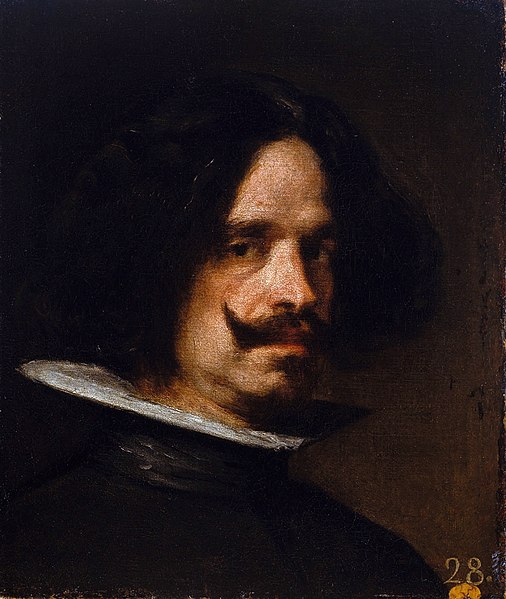
Born: 6 June 1599, Seville
Died: 6 August 1660 (aged 61)
Period: Baroque
The Life of Diego Velázquez
Diego Velázquez was one of the most important painters of the Spanish Golden Age and the leading artist in the court of King Philip IV. Born in Seville, Spain, Velázquez’s early work was rooted in the naturalistic style of the Seville school, where he trained under Francisco Pacheco, his future father-in-law. His initial paintings were of religious subjects, genre scenes, and bodegones (still lifes featuring kitchen items and food, often with figures).
Velázquez’s talent quickly garnered attention, and in 1623, he was invited to the royal court in Madrid, where he painted his first portrait of King Philip IV. The king was so pleased with Velázquez’s work that he appointed him as one of his court painters and later, the principal court painter. This position gave Velázquez access to the highest ranks of society and allowed him to focus almost exclusively on portraiture, through which he became renowned for his keen psychological insights and his ability to convey the dignity of his subjects.
Throughout his career, Velázquez evolved stylistically, moving from the detailed and precise realism of his early work to a looser, more impressionistic approach in his later years. This evolution is evident in his masterworks, which display his sophisticated use of light and shadow, complex compositions, and remarkable ability to capture texture and detail.
One of Velázquez’s most famous paintings, “Las Meninas” (1656), is considered one of the most important and enigmatic works in Western art history. The painting depicts the young Infanta Margarita Teresa surrounded by her entourage in Velázquez’s studio, with the artist himself included in the composition. The complex arrangement of figures and the use of perspective in “Las Meninas” have been the subject of extensive analysis and interpretation.
Velázquez’s work took him beyond Spain; in 1629, he traveled to Italy, where he was influenced by Italian masters. He returned to Italy again in 1649, deepening his understanding of Italian art, which influenced his later work.
In addition to his painting, Velázquez played a significant role in the royal court, taking on various administrative duties, including overseeing the royal art collections. His contributions to art were recognized during his lifetime, and he was awarded the prestigious Order of Santiago by King Philip IV.
Diego Velázquez’s legacy is profound, influencing generations of artists, including the realists and impressionists of the 19th century and beyond. His ability to capture the essence of his subjects and his mastery of technique make him one of the most revered figures in the history of Western art.
Diego Velázquez’s Notable Works
Diego Velázquez is celebrated for his profound influence on Western art, renowned for his masterful depiction of the human condition and his innovative use of perspective and space. Here are ten of his most famous works, each illustrating the depth of his talent and the breadth of his thematic interests:
- Las Meninas (1656) – Often regarded as Velázquez’s magnum opus, this painting depicts the young Infanta Margarita Teresa surrounded by her maids of honor and other court figures, including Velázquez himself. It’s celebrated for its complex and enigmatic composition, intricate play of light, and profound exploration of reality and illusion.
- The Surrender of Breda (1634-1635) – Also known as “The Lances,” this work captures the moment of the Dutch surrender to Spanish forces in 1625. It’s noted for its dignified portrayal of both victors and vanquished and the detailed rendering of the individuals involved.
- The Waterseller of Seville (c. 1620) – One of Velázquez’s early works, this painting showcases his skill in rendering textures and capturing the dignity of common folk, themes that would recur throughout his career.
- Pope Innocent X (1650) – Considered one of the finest portraits ever painted, Velázquez’s depiction of Pope Innocent X conveys the pope’s authority and personality with striking realism and psychological depth.
- Equestrian Portrait of King Philip IV (1635-1636) – This portrait is part of a series of equestrian portraits of the Spanish royal family, showcasing Velázquez’s skill in depicting the grandeur and power of his subjects.
- Vulcan’s Forge (1630) – Representing a scene from classical mythology, this painting is noted for its realistic depiction of the blacksmith god Vulcan and his forge, highlighting Velázquez’s interest in the human form and his mastery of light and shadow.
- Christ in the House of Martha and Mary (c. 1618) – This early work combines a religious scene with a genre scene, using a clever compositional device to merge the biblical story with a contemporary kitchen scene, showcasing Velázquez’s innovative approach to narrative.
- Las Hilanderas (The Spinners, c. 1657) – Allegedly depicting the myth of Arachne, this late work is celebrated for its dynamic composition, vigorous brushwork, and intricate play of perspectives.
- Rokeby Venus (c. 1647-1651) – The only surviving nude by Velázquez, this painting of Venus gazing into a mirror held by Cupid is renowned for its sensuality and subtlety, a testament to Velázquez’s ability to convey texture and form.
- Infanta Margarita Teresa in a Blue Dress (1659) – One of several portraits Velázquez painted of the young infanta, this work is admired for its delicate depiction of the princess and the exquisite rendering of her attire, reflecting the artist’s interest in capturing the innocence and elegance of his royal subjects.
These works exemplify Velázquez’s unparalleled ability to blend realism with psychological insight, his mastery of light and shadow, and his innovative approach to composition, securing his place as one of the greatest painters in the history of Western art.